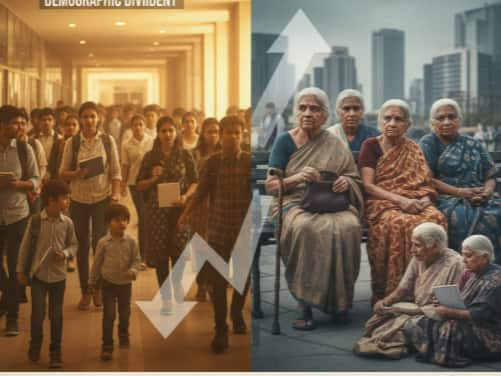India’s demographic dividend is fading as falling fertility and longer lives push the country toward rapid ageing. With weak pensions, fragile care systems, and gendered burdens, the nation faces a closing window to create universal elder security before a looming old-age crisis takes hold.

India is approaching a demographic turning point. The very forces once celebrated for propelling its rise (falling fertility and longer lives) are now quietly reshaping the country into an ageing society with fragile social defenses. What was hailed as a “demographic dividend” now threatens to become a bill coming due, as pension systems built for a younger nation will strain under lengthening retirements and a shrinking base of workers to support them. The bill for decades of demographic optimism is arriving. Writing as two generations, one grounded in public-health administration, the other in health-policy research, we believe India has only a short window to prepare before the numbers overwhelm the promise.
Demographics Are Tilting Towards Age, Region by Region
The numbers tell a quiet but decisive story. According to the Sample Registration System 2023, 9.7 per cent of Indians are now 60 or older, up from 8.6 per cent in 2011. Those aged 65 and above make up 6.4 per cent of the population. By mid-century, India could have 320 million people over 60, nearly one in five citizens. The Longitudinal Ageing Study in India and other national projections show the share of elderly rising faster than most policy plans assume.
The shift is not even. Southern states such as Kerala and Tamil Nadu, having cut fertility decades ago, are ageing years ahead of the national average, with fewer working-age adults to support a swelling older cohort and less time to adapt pensions and health systems. Global risk watchers are also sounding the alarm. The World Economic Forum Global Risks Report 2025 warns that “pension crises will start to bite over the next decade in super-ageing societies” because most systems were built for short retirements and large young workforces. Even countries still riding a demographic bonus, the report notes, are vulnerable if they fail to prepare for longevity. India, long comforted by its youthful profile, is no exception.
Women Bear the Heaviest Cost of Ageing
Ageing is not gender-neutral. Women live longer than men and dominate the ranks of the “oldest old”, those over 75. Yet they often enter later life with thinner savings and weaker pension rights, after decades of lower wages, interrupted employment and unpaid caregiving. Widowhood is common; secure independent incomes are not.
In India, only a small fraction of older women report earnings of their own, leaving many reliant on family support that can be uncertain or precarious. The result is greater vulnerability to poverty, isolation, neglect and poor health. Any credible ageing policy must be gender-responsive and explicitly address the lifetime disadvantages women carry into old age, including pension design and welfare entitlements.
A Grey Head-Start in South India
India’s demographic transition is far from uniform. Southern states that cut fertility early are now ageing ahead of the rest. Their success in reducing births has brought a steeper rise in old-age dependency and fewer working-age adults to support the elderly. Kerala already has one of the country’s highest shares of older residents, and other southern states are following close behind.
As fertility dips below replacement levels (a total fertility rate under 2.1) across much of India, the pace of ageing will quicken elsewhere too. This uneven map matters: a single, national template for social protection, health care and pensions will fail. States need tailored strategies that match where they stand on the ageing curve.
Growing Old Without a Safety Net
Nearly 70 per cent of India’s elderly remain financially dependent, many forced to keep working well past retirement in informal, poorly paid jobs. Only about 29 per cent receive any pension at all. Most lack savings or health security to age with dignity.
Behind this is a vast, fragile care economy. Home care, help with daily living and geriatric services remain overwhelmingly informal, unregulated and undervalued. Studies from our subcontinent highlight chronic problems: inadequate training, caregiver stress, poor pay, a gendered burden that falls on women and patchy infrastructure. Some “silver services”, such as companionship, home support, and conversation partners, may be emerging in cities, but largely as niche, private offerings. A mass, regulated eldercare market has yet to materialise. Meanwhile, a culture of informal family support systems is weakening. More older people now live alone or just with spouses, raising the risks of delayed illness detection, social isolation, dementia and mental-health decline.
This fragility feeds into a looming fiscal challenge. As India edges toward “super-ageing”, with more than a fifth of the population aged 65 and above, there will be fewer workers for each retiree, rising health and long-term care costs and ballooning pension liabilities. Pension systems built for short retirements and younger populations are straining even in rich countries. India’s are thinner still: formal pensions cover only a minority of government and organised-sector workers, while nearly 90 per cent of employment is informal and poorly protected. The shift from defined-benefit (DB) to defined-contribution (DC) schemes such as the National Pension System (NPS) has capped state liabilities but pushed investment risk onto individuals least able to bear it.
If India is to avoid an old-age crisis, it needs a bold rethink: universal minimum pensions to guarantee dignity, integration of health and long-term care, and a regulated, professionalised care economy that values the work mostly done by women. The window to build such a safety net is closing.
Elder Security Frameworks: A Plan to Grow Old with Dignity
India has so far relied on modest social pensions, family transfers and the hope that informal care will somehow hold. That bargain may be fraying. Longer lives, shrinking households and a workforce dominated by informal jobs have left millions of older people financially exposed and poorly supported. Health systems remain curative and hospital-centric, with scant investment in prevention, rehabilitation or long-term care. Care work itself is treated as invisible and low value.
The country still has time, perhaps a decade or two, before the fiscal and social pressures of super-ageing become overwhelming. But delay now will make reform costlier and politically harder later. What is needed is not a single scheme but a coherent “Elder Security” framework: a set of protections that treat ageing as a life-course challenge rather than a late-life emergency.
Universal minimum pension with Tiered top-ups
Guarantee a basic, non-contributory pension to every older person beyond a set age. Layer on voluntary contributions, employer matching where possible and state incentives to build higher retirement income without leaving anyone behind.
Integrate health and long-term care
Move beyond hospital-centric care. Fold geriatric services, home care, rehabilitation, palliative support and preventive health into one life-course “elder security” package.
Formalise the care economy
Set standards and accreditation for caregivers, invest in training and fair pay, and support social enterprises and women-led care businesses. Link health, welfare and labour schemes to build a real care market.
Put older women first
Close gender gaps in pension enrolment, use gender budgeting to direct resources, and ensure widows and single elderly women are protected.
Tailor state roadmaps to different ageing speeds
Kerala, Tamil Nadu and other fast-ageing states need rapid rollout of pensions and elder-care systems; others can phase in but must start building infrastructure now.
Nudge retirement saving in the informal sector
Use auto-enrolment, micro-pension schemes, matching subsidies and behavioural nudges to help informal workers build modest but reliable savings.
Invest in data and innovation
Expand LASI and other longitudinal ageing surveys, track health and care outcomes, and support technology-driven elder care — from telehealth to AI-assisted monitoring.
A Pact Across Generations
India has one chance to turn longer lives into a strength rather than a strain. The costs of inaction will fall not only on today’s elderly but also on the young, who will inherit weaker pensions, heavier care burdens and tighter public finances. This is not a question of protecting “them”; it is about designing a society where ageing does not mean insecurity, where budgets remain solvent and where social bonds endure despite smaller families and longer retirements. On this International Day of Older Persons, India would do well to replace demographic complacency with preparation while choice is still possible and before crisis dictates the terms.
Empower your business. Get practical tips, market insights, and growth strategies delivered to your inbox
By continuing you agree to our Privacy Policy & Terms & Conditions
